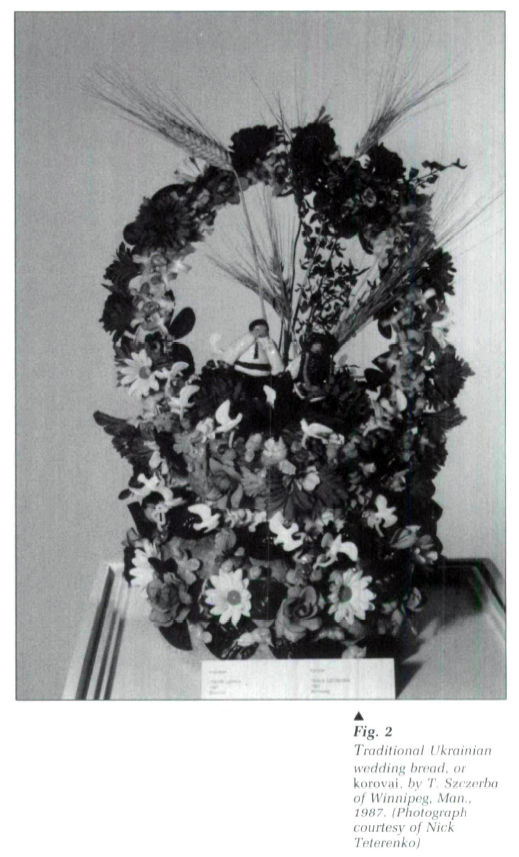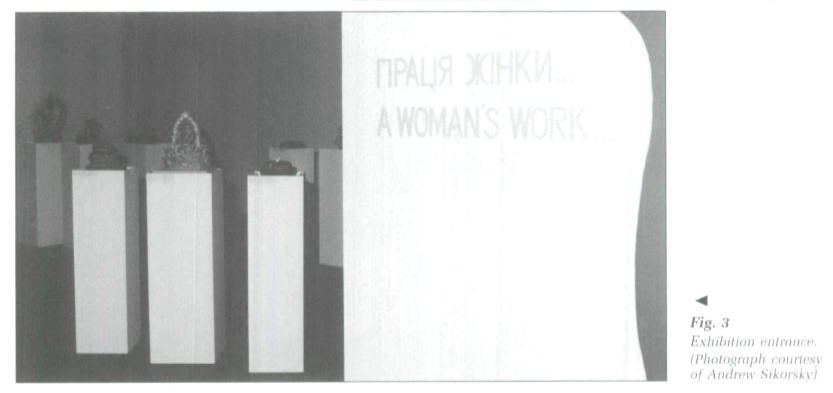Exhibitions and Collections / Expositions et collections
"A Woman's Work":
Curator's Report
INSTALLATION: Michael Zujac.
LIGHTING: Harry Hillman.
Duration: 6 December 1987 to 31 January 1988.
1 Our conceptual approach for an exhibition on Ukrainian ritual breads was to some extent an outgrowth of the stimulating work of others who, like Judy Chicago,1 had embedded in the public consciousness the notion that so-called women's work can be art. Chicago and her associates employed various skills, including traditional and non-traditional craft techniques, but shifted the context of their display from shopping centres and church basements to exhibition environments that are normally used to isolate and define expressions of art.
 Display large image of Figure 1
Display large image of Figure 12 The craft-as-art that this exhibition focussed upon was Ukrainian ritual bread which has its roots in prehistory and prevails today within the Ukrainian-Canadian community at major celebrations such as Christmas and weddings. For "Oseredok" (which means "centre" in English and serves as the local nickname for Winnipeg's Ukrainian Cultural and Educational Centre), this exhibition proved to be one of its most successful ever: it had everything—community involvement, beautiful objects to exhibit, striking design and lighting, volunteer participation, an exhibition catalogue, lots of good will, generous lenders and talented artists. The experience proved that a small institution like ours could undertake a relatively complex exhibition project and succeed on a shoestring budget.
3 We began our curatorial preliminaries and research in the fall of 1986. At the onset, it was decided to scout the local Ukrainian community and obtain one hundred breads for the exhibition. Initially, this seemed an unreachable goal. We finally assembled approximately two hundred specimens, almost all of them provided voluntarily by their makers as loans to the exhibition. Some of these were brought in "fresh" only hours before the exhibition opening. Fortunately, we foresaw this problem and allowed for flexibility in installation and design to accommodate late deliveries.
4 The exhibition catalogue for "A Woman's Work" was professionally designed by our long-time volunteer. Orest Kinasewych, and included the photographic artistry of David Firman of Winnipeg. The result of their combined efforts was cited with an award by the Western Canada Art Association (category: "photographic reproduction in full colour catalogues"). At the conclusion of the exhibition, breads were selected for possible inclusion in the Centre's permanent collections. Our curatorial aide, Nick Teterenko, arranged for over a quarter of the specimens to be donated by their lenders for this purpose.
 Display large image of Figure 2
Display large image of Figure 2 Display large image of Figure 4
Display large image of Figure 4 Display large image of Figure 5
Display large image of Figure 55 Visitors to the exhibition were able to appreciate the diversity of breads and decorative elements inherent in their construction. We found that placing a bread upon a white pedestal very dramatically underlined its aesthetic value and related it to other, more accepted and established art forms such as sculpture. This display technique was instrumental in helping us convince the viewer that the making of a Ukrainian ritual bread is a creative process that goes beyond simple utilitarianism or ritual enhancement.
